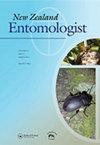Cafioquedus gularis Sharp, 1886 and other poorly understood Staphylinini: a review of the New Zealand fauna of the tribe with discussion of its potential for biogeography (Insecta: Coleoptera: Staphylinidae)
IF 0.4
4区 农林科学
Q4 ENTOMOLOGY
引用次数: 6
Abstract
ABSTRACT The formation of New Zealand's terrestrial biota is a subject where conclusions depend strongly on the properties of the focal organisms. Here, we bring the systematic knowledge of the New Zealand fauna of the very diverse rove beetle tribe Staphylinini closer to the level appropriate for biogeographic research. In particular, the hitherto puzzling New Zealand endemic genus Cafioquedus is considered a member of the Creophilus-complex (Staphylinina), while several other endemic species proved to be misidentifications of common introduced species. With these taxonomic updates, and taking into account the relative age and extant distributions of lineages that occur in New Zealand, we conclude the following: 1. the New Zealand Staphylinini are dominated (66%) by the endemic members of the subtribe Amblyopinina, which are likely Gondwanan paleoendemics; 2. species from the Creophilus- and Cafius-complexes (Staphylinina and Philonthina, respectively), are neoendemics (15%), possibly resulting from trans-oceanic colonisation; 3. human-transported adventive species (19%) form the notable, most recent and taxonomically heterogeneous component of the New Zealand fauna. Cafioquedus gularis Sharp, 1886 is redescribed. The following new combinations and synonymies are proposed: Philonthus longicornis Stephens, 1832 = Philonthus burrowsi (Broun, 1915), comb. nov., syn. nov.; Philonthus politus (Linnaeus, 1758) = Philonthus ohiaensis (Broun, 1923), syn. nov.; Philonthus umbratilis (Gravenhorst, 1802) = Philonthus insularis (Bernhauer and Schubert, 1916), syn. nov.; Sphingoquedius novaezeelandiae (Duvivier, 1883), comb. nov. = Sphingoquedius mannaiaensis (Cameron, 1945), comb. nov., syn. nov.; Quediomimus hybridus (Erichson, 1840), comb. nov. = Quediomimus taurus (Blackburn, 1888), comb. nov. = Quediomimus brookesi Cameron, 1948, syn. nov. A lectotype is designated for Philonthus insularis (Bernhauer and Schubert, 1916).Cafioquedus gularis Sharp, 1886与其他尚不清楚的葡萄球菌:新西兰属区系综述及其生物地理学潜力的探讨(昆虫纲:鞘翅目:葡萄球菌科)
新西兰陆地生物群的形成是一个主题,结论强烈依赖于焦点生物的特性。在这里,我们将非常多样化的漫游甲虫部落Staphylinini的新西兰动物群的系统知识更接近于适合生物地理研究的水平。特别是,迄今为止令人困惑的新西兰特有属Cafioquedus被认为是Creophilus-complex (Staphylinina)的一员,而其他几个特有物种被证明是普通引进物种的错误鉴定。根据这些分类更新,并考虑到在新西兰发生的谱系的相对年龄和现存分布,我们得出以下结论:新西兰葡萄球菌以Amblyopinina亚部落的特有成员为主(66%),可能是冈瓦纳古地方性的;2. 来自Creophilus-和cafius -复合体(分别为Staphylinina和Philonthina)的物种是新本地物种(15%),可能是跨洋定殖的结果;3.人类迁移的外来物种(19%)构成了新西兰动物群中最重要的、最新的和在分类上异质性的组成部分。重新描述了1886年的Cafioquedus gularis Sharp。提出了以下新的组合和同义词:Philonthus longicornis Stephens, 1832 = Philonthus burrowsi (brown, 1915), comb。十一月,同义词十一月;politus (Linnaeus, 1758) = Philonthus ohiaensis (brown, 1923), syn. 11 .;黑树飞蛾(Gravenhorst, 1802) =岛飞蛾(Bernhauer and Schubert, 1916), syn11 .;Sphingoquedius novaezeelandiae (Duvivier, 1883),梳子。11月=曼乃氏Sphingoquedius mannaiaensis (Cameron, 1945),梳子。十一月,同义词十一月;杂交魁地鼠(Erichson, 1840),梳子。11月=金牛座魁地鼠(Blackburn, 1888),梳。11月= Quediomimus brookesi Cameron, 1948, syn11 .一个选型被指定为岛菲龙thus insularis (Bernhauer and Schubert, 1916)。
本文章由计算机程序翻译,如有差异,请以英文原文为准。
求助全文
约1分钟内获得全文
求助全文
来源期刊

New Zealand Entomologist
ENTOMOLOGY-
CiteScore
0.70
自引率
33.30%
发文量
3
审稿时长
>12 weeks
期刊介绍:
The invertebrate diversity of New Zealand is of great interest worldwide because of its geographic isolation and geological history. The New Zealand Entomologist plays an important role in disseminating information on field-based, experimental, and theoretical research.
The New Zealand Entomologist publishes original research papers, review papers and short communications. We welcome submissions in all aspects of science regarding insects and arthropods in a New Zealand or Australasian setting. The journal’s subject matter encompasses taxonomy, phylogenetics, biogeography, biological control and pest management, conservation, ecology and natural history.
The journal is the official publication of the Entomological Society of New Zealand. Papers published or submitted elsewhere for publication will not be considered, but publication of an abstract or summary elsewhere (e.g. conference proceedings) does not preclude full publication in the New Zealand Entomologist. Accepted papers become copyright of the Entomological Society of New Zealand. The journal is published in English, but we also welcome publication of abstracts in Maori.
 求助内容:
求助内容: 应助结果提醒方式:
应助结果提醒方式:


